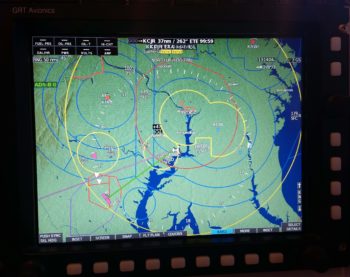As I mentioned last night, today I started out by doing a decent amount of research in the manuals to see what I could find out regarding my panel issues. I fired up the panel to check on a few things, and set my full screen map in prep for Panel Overview video #2 that I was getting ready to shoot. Although I point it out in the video, the green highlight text in the upper left hand corner denotes that ADS-B is on, alive and well.
I also checked some parameters to get a general feel for how I’m going to link the Electroair spark advance display. I think the spark advance meter lead is most likely 12V output, so instead of conveniently hooking up it to my Engine Info box less than a foot away –all neatly stashed away in the GIB’s headrest– I’m going to have to run the wire up to the panel to connect it to the HXr for display. Not a big issue at all, just a bit easier the other route. BTW, AUX inputs to the EIS can only be 5V, thus the reason it would have to make its journey forward in the fuselage.
I then took my second video on the Instrument Panel, detailing some of the things I left out of my last video. Here it is:
As the video was rendering, and armed with just enough knowledge (so I sez to myself… ha!) I called Trio and talked to Jerry about my autopilot not receiving a GPS signal. It had before, so what changed I asked him . . . of course as the words were leaving my mouth I had an epiphany. Something had changed. With my newfound knowledge on GRT EFIS functionality, I had switched the A/P source select to “EFIS.” It then came back to me that the very first time I fired up the autopilot it immediately synched to the GNS480 (the A/P source select switch being set on “GPS . . . doh!) . . . and now set on “EFIS” it wasn’t working. Therein lied the problem: it was the connection between EFIS GPS and the Trio autopilot.
When I had talked to Chuck a few months ago, he (and the Pro Pilot manual) said that when the A/P source select switch was on “EFIS,” the autopilot was looking for NMEA GPS data. This was perfect since this is exactly the format that the GRT GPS puts out. Today though, Jerry said that Aviation GPS data should be used if I’m not getting a GPS signal (to be fair, Chuck told that if I could use Aviation GPS data, I should).
Not bragging! But in my mind it took about 30 seconds after I had my epiphany and Jerry’s input to figure out my plan of action…
My GRT HXr GPS is connected as such: First, there is a GPS antenna connected straight to the AHRS. Out of the AHRS wiring bundle is an RS232 GPS OUT wire to Bus A on the HXr. This same RS232 GPS OUT lead, immediately after it departs the wiring bundle, splits off and connects to the “EFIS” side of the A/P source select switch.
The NMEA GPS data enters the HXr on the RS232 Rx half of Serial #1. The good thing for me is that the other side of Serial #1, the RS232 Tx half of the pair, was currently empty. Since each port is programmable, I merely cut the wire from the AHRS GPS OUT to the Trio autopilot right near the “Y” junction close to AHRS wire bundle. With a new unattached wire then coming from the autopilot, I terminated the end of it with a socket and plugged it into the HXr Bus A RS232 Tx Serial #1 port. When I fired up the panel I recoded the previously empty port to handle GPS Aviation data (vs. NMEA data). The Trio Autopilot immediately came online and the display lit up like a Christmas tree!
(Note the A/P source select switch in the pic below)
Online/connected Trio autopilot receiving GPS signals from the HXr EFIS GPS. (Note the traffic alert in the lower left corner of the EFIS).
With some physical wiring changes that just occurred, I spent a good half hour updating the associated electrical wiring diagrams.
Later in the evening I got a response back from Jeff at GRT on my forum questions regarding the Mini-X not being able to see the External flight plan generated on the GNS480. Well, not surprisingly I was missing a few key menu-set parameters on HXr and the Mini-X, that once I cleared up I had the immediate ability to view GNS480-generated flight plans on the Mini-X!
So not a bad day today…. not only have I flushed out some major issues in the last few days, but Ive been able to find the correct information to fix them. Hoo-ah!





